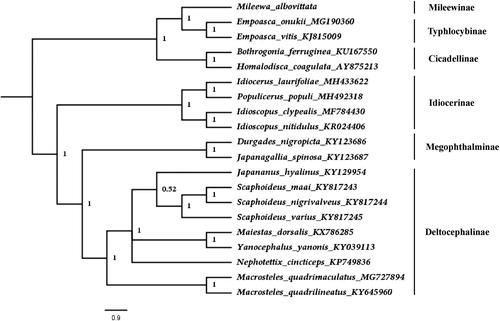Abstract
The complete mitochondrial genome of Mileewa albovittata was sequenced and annotated from this study. The circular mitogenome is 15,079 bp in length, containing 13 protein-coding genes (PCGs), 22 tRNA genes, two rRNA genes, and one AT-rich region. The total length of 13 PCGs is 10,965 bp, responsible for encoding 3640 amino acids. Eleven PCGs have ATN as the start codon, except for ATP8 and NAD5 genes have TTG. Twelve PCGs have TAA as the stop codon, while the COII gene has an incomplete stop codon (A). The LSU and SSU of rRNA gene are 1220 bp and 749 bp, respectively. Novel insight on taxonomy of Cicadellidae was provided with phylogenetic analyses among mitogenome sequences from 20 related species.
The subfamily Mileewinae contains species with small- to medium-sized, slender, usually darkly pigmented body. They inhabit in humid tropical forests worldwide, and always occur on herbaceous vegetation in the understory (Dietrich Citation2011). Mileewini, the largest and most widely distributed tribe of Mileewinae (Krishnankutty and Dietrich Citation2011), includes four genera: Amahuaka Melichar, Mileewa Distant, Ujna Distant, and Processina Yang, Deitz and Li. They distribute in the Ethiopian, Oriental, and Neotropical regions. Mileewa albovittata is one species in the genera Mileewa Distant that widespread in China (Yang et al. Citation2017). Due to the poorly delimitation of the subfamily Mileewinae, molecular data is needed to discuss the taxonomic status among species in family Cicadellidae.
A male adult was selected as specimen, which was collected from Simianshan, Jiangjin, Chongqing, China, in September 2018. The sampling site had the altitude 1022 km. Total DNA was extracted from the entire body without abdomen. Qiagen DNeasy kit was applied with the instruction of manufacture. The male genitalia was deposited in the Institute of Entomology, Guizhou University, Guiyang, China. Library was prepared and sequenced for 150 bp paired-end reads using HiSeqXten platform at Sangon Biotech (Shanghai, China). The reads were assembled and annotated using Geneious v9.1.5, with reference sequences from Homalodisca coagulata (accession number AY875213) and Bothrogonia ferruginea (accession number KU167550). According to reference sequences, 37 typical invertebrate mitochondrial genes (13 PCGs, 22 tRNAs, and 2 rRNAs) and the A + T-rich region (D-loop) were identified from mitochondrial genome of M. albovittata. Annotated sequence of M. albovittata mitogenome was submitted to GenBank with accession number MK138358.
The circular mitogenome of M. albovittata is 15,079 bp in size. The A + T content is 79.6%, which is within the range reported for hemipteran mitogenomes (Zhang et al. Citation2014). Among them, the total length of 13 protein-coding genes (PCGs) is 10,965 bp, encoding 3640 amino acids. Eleven PCGs have ATN as the start codon, except for ATP8 and NAD5 genes have TTG. Twelve PCGs have TAA as the stop codon, while the COII gene has an incomplete stop codon (A). The LSU (16S) and SSU (12S) of rRNA gene are 1220 bp and 749 bp, respectively. All the 22 tRNA genes have the conserved triple nucleotides recognizing the corresponding codon.
Phylogenetic relationship was constructed on nucleotides sequences of 13 PCGs among M. albovittata and 19 reference species from five subfamilies in family Cicadellidae. Bayesian inference (BI) methods under the GTR + G + I model and running for 10,000,000 generations with a sampling frequency of 100 generations was used through Mrbayes v3.2.0 (Ronquist et al. Citation2012). The results showed that species from same subfamilies were all clustered into same clade, respectively (). Mileewa albovittata was distinct but close to two species in subfamily Typhlocybinae, and two in subfamily Cicadellinae, which were always considered as sister group in family Cicadellidae by morphology (Dietrich Citation1999).
Figure 1. Phylogenetic tree constructed with MrBayes v3.2.0 (Ronquist et al. Citation2012) under the GTR + G + I model and running for 10,000,000 generations with a sampling frequency of 100 generations.

Disclosure statement
No potential conflict of interest was reported by the authors.
Additional information
Funding
References
- Dietrich CH. 1999. The role of grasslands in the diversification of leafhoppers (Homoptera: Cicadellidae): a phylogenetic perspective. In: Warwick C, editor. Proceedings of the Fifteenth North American Prairiie Conference. Bend (OR): Natural Areas Association; p. 44–48.
- Dietrich CH. 2011. Tungurahualini, a new tribe of Neotropical leafhoppers, with notes on the subfamily Mileewinae (Hemiptera, Cicadellidae). Zookeys. 124:19–39.
- Krishnankutty SM, Dietrich CH. 2011. Review of Mileewine leafhoppers (Hemiptera: Cicadellidae: Mileewinae) in Madagascar, with description of seven new species. Ann Entomol Soc Am. 104:636–648.
- Ronquist K, Teslenko M, van der Mark P, Ayres DL, Darling A, Höhna S, Larget B, Liu L, Suchard MA, Huelsenbeck JP. 2012. MrBayes 3.2: efficient Bayesian phylogenetic Inference and model choice across a large model space. Syst Biol. 61:539–542.
- Yang MF, Meng ZH, Li ZZ. 2017. Hemiptera: Cicadellidae (II): Cicadellinae. Fauna Sinica: Insecta, vol. 67. Beijing, China: Science Press.
- Zhang B, Ma C, Edwards O, Fuller S, Kang L. 2014. The mitochondrial genome of the Russian wheat aphid Diuraphis noxia: large repetitive sequences between trnE and trnF in aphids. Gene. 533:253–260.
